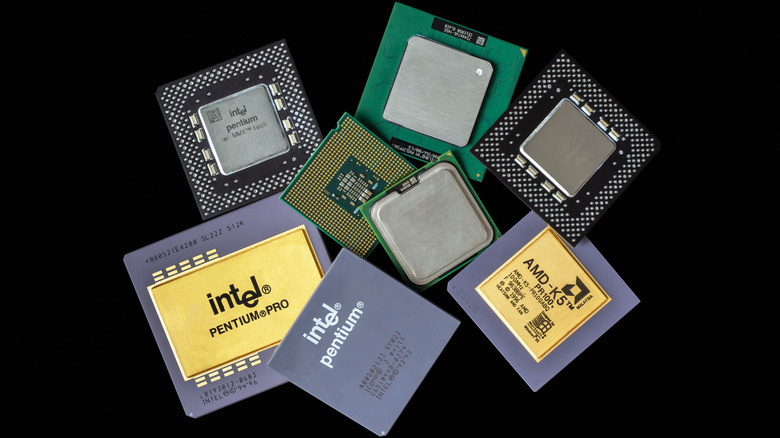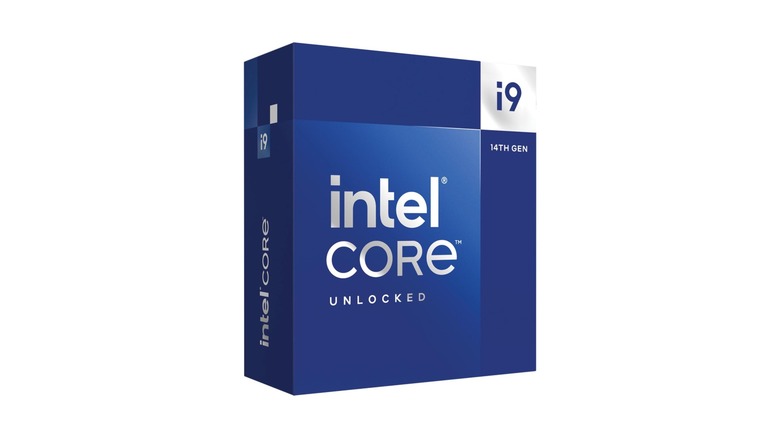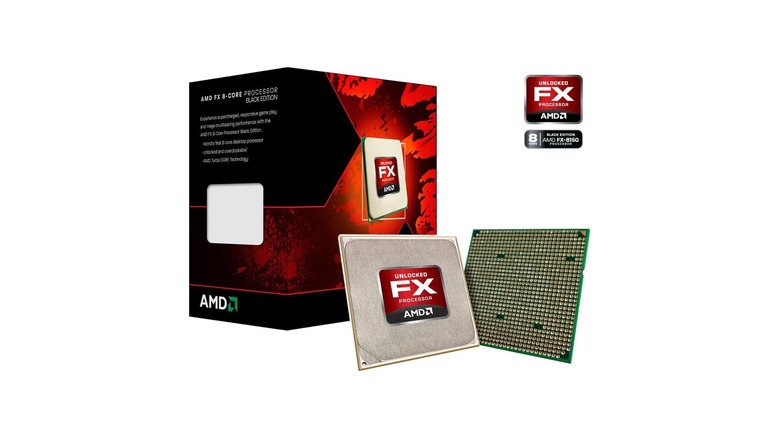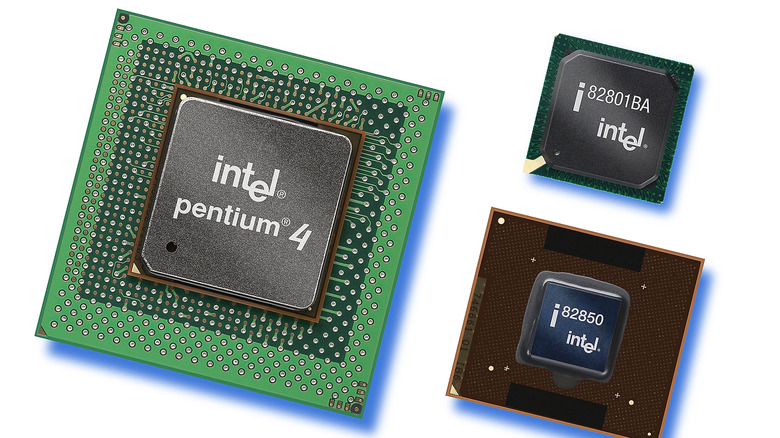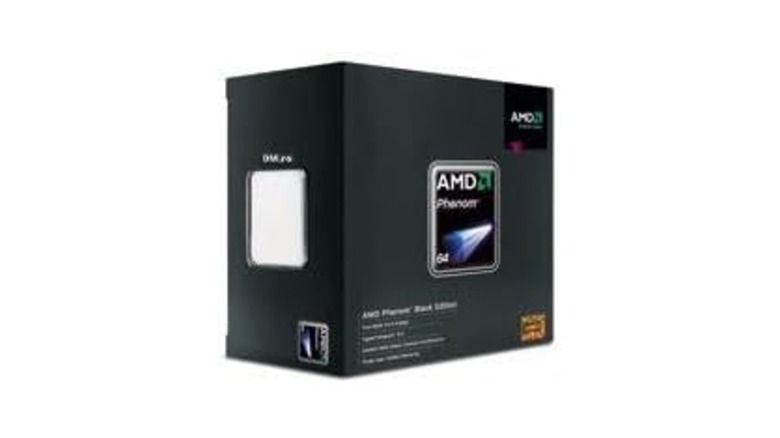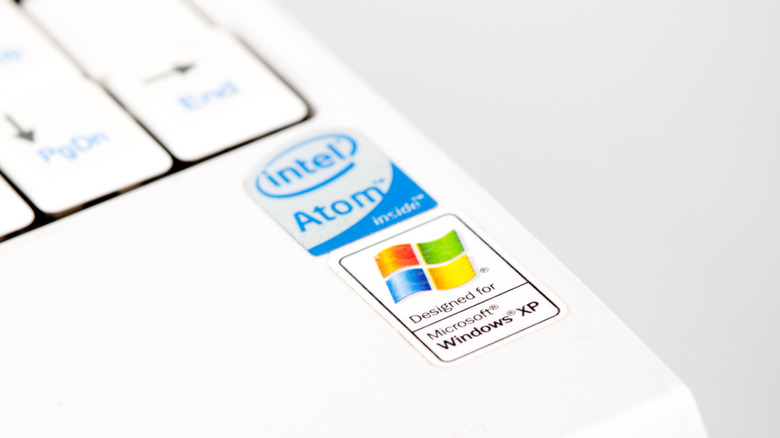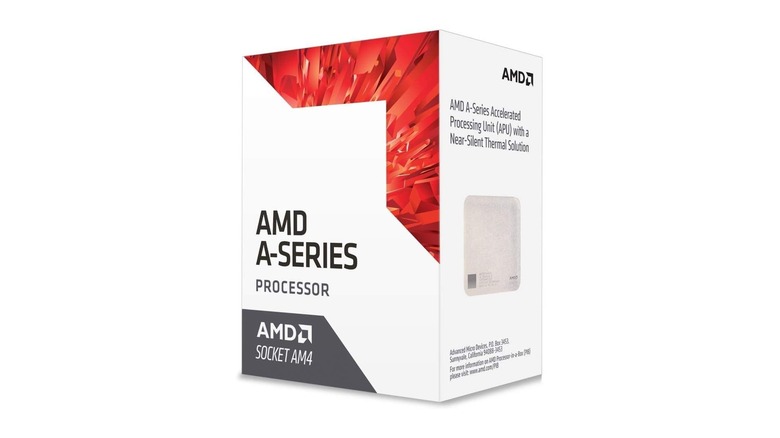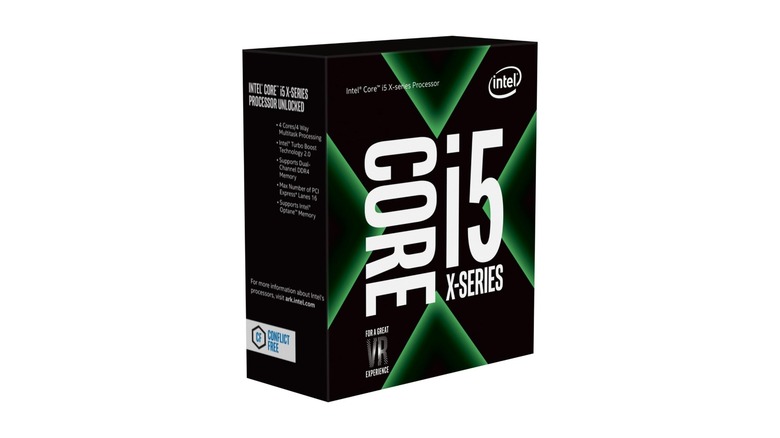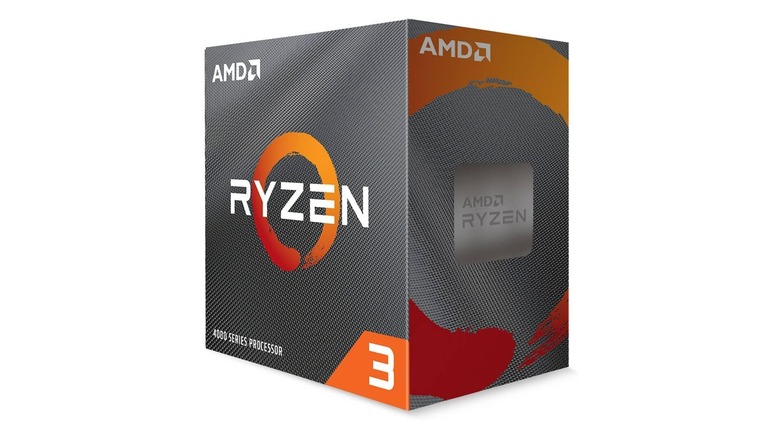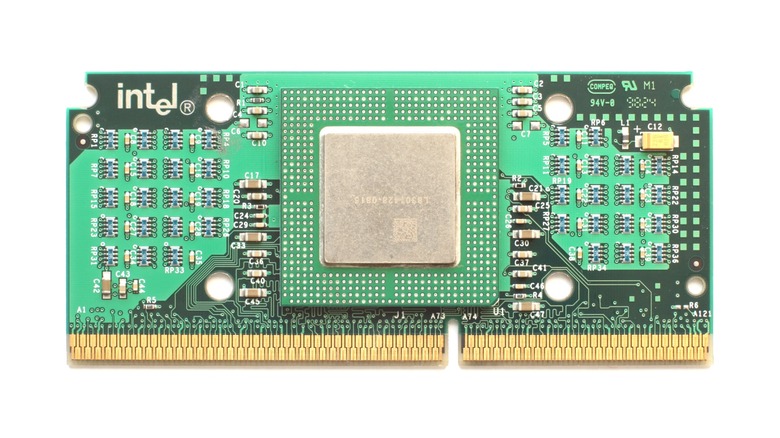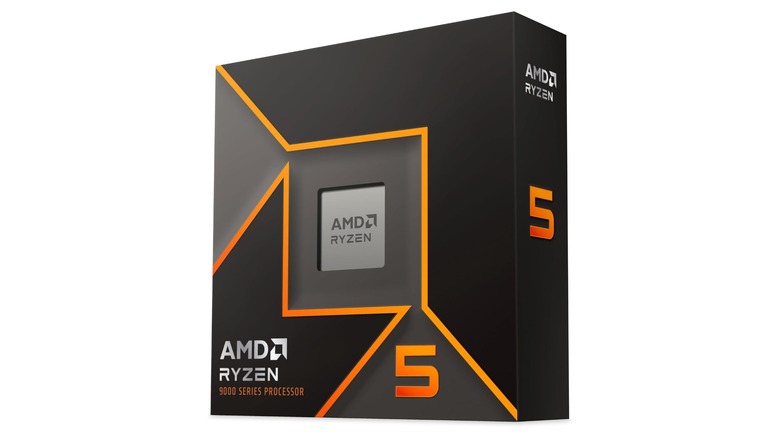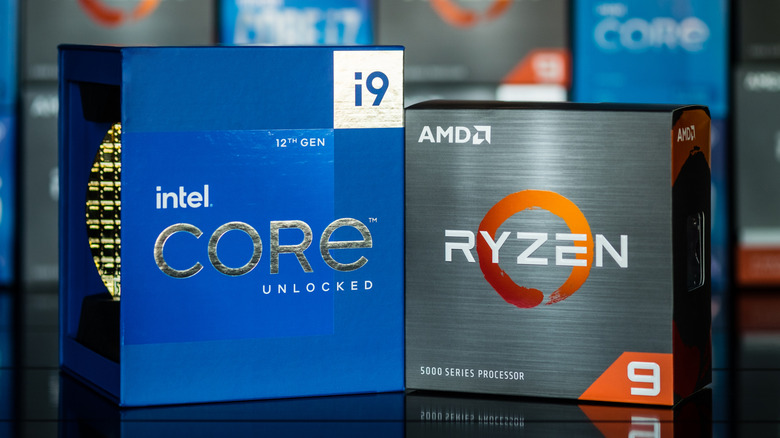10 Of The Worst CPUs Released By Intel And AMD
We may receive a commission on purchases made from links.
Depending on who you ask, CPUs might top a list of the most important components you can find in a computer. People spend a lot of focus on these pieces of tech, with debates over their two biggest manufacturers — AMD and Intel — being commonplace online. While both brands have been very competitive throughout their history, certain products have led them to be painted in a very poor light. Some of the worst CPUs released by AMD or Intel were unable to compete well with rival products at launch — and a few were unable to even work properly.
Today, you'll only really find discussions on Intel and AMD processors. While other companies like Apple and Qualcomm have thrown their hat into the ring, those brands are often left out of any debates due to their limited use cases. Custom gaming PC builders really only use Intel or AMD CPUs, so being aware of their best traits can matter a lot when trying to get your hands on a quality system. Likewise, knowing which processors have stood out for their poor results can save you from wasting money on systems that were bad choices from the beginning.
Intel: Core i9-14900K
In a perfect world, the Intel Core i9-14900K wouldn't even be considered for this list. It's one of the most powerful desktop processors you can find for both productivity and gaming even today. Its only major flaws involve power consumption and heat levels, with both of these measurements reaching very high even when compared to more powerful CPUs. Unfortunately, this is exactly where the 14900K runs into its greatest flaw, with its power consumption leading to massive stability issues.
As a result of the 14900K's default operating voltage, its degradation was massively accelerated, which led to Alderon Games putting out a notice that they were observing 100% failure rates in certain benchmarks for every tested CPU. These problems were found in other 14th-gen and 13th-gen processors from the company, but this one in particular was notable due to being a flagship model and drawing the most power of them all.
Even with BIOS updates seemingly solving the issue, many prospective buyers continue to be wary of Intel's products for fear of this advanced degradation happening to them. Today, the 14900K is a very powerful processor that's worth looking into, but it stands as a symbol of Intel's recent reputation being dragged through the mud — even if its stability issues aren't a problem anymore.
AMD: FX-8150 & Other FX Processors
AMD's FX Bulldozer chips, which were first released in 2011, have also earned a bad reputation. The FX-8150 in particular was especially problematic as it was advertised as the first eight-core desktop CPU available for retail, but it was actually using different modules that were only classified as cores by AMD's definition. This led to a massive lawsuit that ended with a settlement in 2019 and cost the company over $12 million. While not the same sort of technical flaw that Intel's latest Core CPUs had, it certainly helps show why AMD wasn't considered a strong competitor up until its Ryzen processors were launched in 2017.
Even when ignoring the questionable advertising, the FX-8150 wasn't all that great of a CPU on its own. It would commonly fall behind in benchmarks compared to both competing Intel alternatives and even previous AMD processors. Its middling performance left a lot to be desired for those who wanted a major upgrade, and the Bulldozer platform as a whole ended up being loathed by avid PC builders after its time. AMD was still well off enough to last up to today, but the FX lineup was far from what it needed to truly be considered as a serious rival to Intel.
Intel: Pentium 4
Intel's Pentium 4 processor wasn't particularly impressive at its launch in 2001, which was a time when AMD could actually compete without a need for the Zen platform. This made the Pentium 4's shortcomings far more detrimental in the long run, where its speed boosts were countered by its architectural changes and its high voltage led to a higher need for powerful coolers. This makes it a mirror to the FX lineup, as both poor-performing processors acted as a prelude to each company's eventual domination in the market.
The Pentium 4 is among the earliest processors on this list, having first been revealed in the new millennium. This wasn't the first misstep Intel took, either, but it still stands out to many as one of the biggest shortcomings for the company in those early years. Although it's neither a complete technical mess nor something that led to massive lawsuits, the Pentium 4 still couldn't live up to the expectations consumers had for it.
AMD: Phenom 9900/9950
When AMD launched its Spider platform in 2007, it was made out as something with quite a lot of promise. However, while it was fast compared to previously-released processors, the performance increase wasn't actually all that exciting when looking at what Intel could offer. Flagship Spider CPUs couldn't compete with the Core 2 Quad, which released half a year earlier. While Intel's option was more expensive, the price difference wasn't enough for AMD to finally score a win.
Interestingly, while many reviewers of the platform mention the Phenom 9900, only the 9950 was actually available for the average consumer. The only difference between each CPU seems to be the name, with the 9900 likely being limited to review samples. Regardless, neither one managed to impress people, and both were quickly ignored in favor of Intel's alternative. The Spider platform wouldn't be so bad if AMD was the only available manufacturer at the time of its release, but its struggles allowed Intel to continue dominating the market.
Intel: Atom x7-Z8750
The Intel Atom processors were designed to be as power-efficient as possible. Indeed, the flagship x7-Z8750 was exactly that, being rated with a Scenario Design Power (SDP) of only 2 watts and often expected to draw even less power than that. As one might expect, though, that means even the flagship Atom delivered lackluster performance, and was only found in pocket-sized computers. It's really just something that should be expected from a processor that's meant to be low-power in every sense.
So what type of computer would feature the x7-Z8750? Check out SlashGear's 2016 GPD WIN Review. While it was impressive in terms of size and capabilities, it was also billed as a gaming machine that struggled to play anything at decent frame rates. Admittedly, our review model used a slightly less powerful processor, the Z8700, but the jump in performance from that unit to the Z8750 wasn't much. The Atom processors were doomed to fail simply by design, especially as increasingly powerful smartphone processors were on the rise.
AMD: A6-9500
AMD's A6-9500 is likely not a processor you've heard very much about. Discussions regarding the unit online range from people asking what the point of it is to tech channels noting how no one has bothered to review it. It's most notable for being one of the earliest processors to use the AM4 socket that would one day become the basis for the popular Ryzen line. However, this meant it was also perhaps the worst CPU you could put into that socket. Even with its low cost and integrated graphics, the A6-9500 was hardly worth getting over any other AM4 choice.
Even if you wanted something with lower power consumption, there was a variant of this processor called the 9500E. Outside of a 30W reduction in Thermal Design Power (TDP), the only major difference was a slight reduction in clock speed — which likely wouldn't matter anyway, considering the existing lack of good performance. There was also the A6-9550, which attempted to make up for the performance woes with a higher clock speed instead. As such, it's hard to justify a purchase for the A6-9500 even when it's up against other early AM4 processors.
Intel: Core i5-7640X
Intel's Core i5-7640X was in strange position of being both great and poor value at the time of its release. Although it had a decently low cost, it also required an expensive motherboard with the X299 chipset. This was usually only reserved for high-end chips that were priced hundreds of dollars higher than normal consumer processors, so those boards couldn't reach their full potential with this CPU. Even when comparing its gaming performance to alternatives with more common motherboards, the 7640X doesn't impress enough to justify the extra cost of its platform.
The 7640X's biggest issue echoes the A6-9500's, but in this case, there isn't a great upgrade path after settling on Intel's CPU. Even after its release, there was a plenty of of consumer level processors compatible with Intel's less expensive motherboards, while the X299 chipset required these expensive components. It hardly counted as a budget pick, and yet the 7640X was one of only a few reasonably-priced processors that could fit in its socket.
There was hardly a justification for getting it on release, even if you just wanted something cheap to tide you over before buying a more capable CPU later on.
AMD: Ryzen 3 4100
Although the current sub-$100 price of the AMD Ryzen 3 4100 seems very attractive, context puts it in a different light. It came out at a time when the question of whether AMD or Intel made the better CPU became a question open for genuine debate. While Intel was starting to lose its lead, it was still extremely capable in terms of budget-friendly offerings.
While the 4100 managed power consumption well, it consistently fell short in benchmark testing against the similarly-priced Core i3-12100. Even against the Ryzen 5 4500, a processor that was only $30 more expensive at launch, its performance issues were worryingly noticeable.
The value of the Ryzen 3 4100 has only worsened with time. Today, you can find both it and the 4500 on sale from official retailers. Their prices often dip around to $60, causing the 4500's gap in strength to become even more apparent. While many would argue that 4-core CPUs aren't obsolete yet, it's hard to justify purchasing one today when a 6-core alternative is just as easy to get.
Intel: Covington Celeron
Also known as Covington, the very first Intel Celeron processors are the oldest CPUs you'll find on this list, having been released in 1998. While the Celeron brand would prove to have plenty of staying power, the release of these early processors was soured by one fatal flaw — the lack of L2 cache.
This caused earlier Pentium CPUs to handily beat them out in just about any test or benchmark you could imagine. It's a wonder how they managed to release without cache in the first place, especially with all of the negative press Intel received almost immediately over the omission.
The next Celeron — which arrived as soon as Intel could release it – featured the missing L2 cache. It was also the first processor of its kind to feature the cache directly on the die itself, which speaks volumes on the poor reception of the Covington CPUs. While Intel's latest Ultra processors leave a lot to be desired — especially against AMD's current offerings — it's hard to imagine any of their modern CPUs missing such an important function out of the box.
AMD: Ryzen 5 9600X
The AM5 processors are perhaps the best examples of why Intel lost its CPU crown to AMD, thanks to their stellar performance and relatively low cost. The budget market continues to have less obvious winners, however, with units like the Ryzen 5 9600X not managing quite as well as it could.
The Ryzen 5 9600X had a launch price of $280, which led reviewers to criticize its value, as it could barely hold its own against the i5-14600K. A difference of $40 would net you a far better processor if you wanted to go to Intel's platform instead, and even the similarly-priced Ryzen 5 7600X was often able to outdo its successor in gaming tests.
The 9600X is still a good processor on its own. However, with how much market share AMD has gained over Intel recently, you would expect it to compete well when targeted towards buyers with tight budgets. As one of the earliest Zen 5 processors, the Ryzen 5 9600X called the whole platform into question, with expectations only stabilizing after the release of the higher-end 9800X3D.
Although it's not a technical mess or a massive sales flop, it's an example of why companies shouldn't always rest easy when they're on top.
Methodology
Processors on this list were chosen based on a number of different factors. Each one was measured by how much power and performance at their time of launch, as well as pricing and whether they suffered from any fatal flaws. The impact they had on their manufacturers is also considered, with the 14900K issues damaging Intel's image to a point where people still hesitate to buy it even today.
Your mileage may vary with each CPU mentioned here. Chances are, you were able to avoid any issues whatsoever with a Covington Celeron machine you had as a kid, or you might have been able to find the Ryzen 5 9600X on sale for a fantastic price. What makes a processor good or bad depends more on its use cases than anything else, and if you keep your expectations low, most of the ones mentioned on this list are perfectly fine for just browsing the web or handling extra-light gaming.
Of course, some processors are more capable than others, and it's not too hard to see why a few of them gained the negative reputation they still have today.
